Sea Monster Week
Posted by: Loren Coleman on July 14th, 2008
Darren Naish, over at Tetrapod Zoology, just rolled through five days, last week, of sea monster photographs and remarks about the mostly fake, false, or misleading images. Let’s take a look.
First up was the March 1965 photograph (below) from Robert Le Serrec of a huge, tadpole-like creature encountered in Stonehaven Bay, Hook Island, Queensland, Australia. The case has been rather universally labeled a hoax. I mentioned in my field guide that Interpol was even after the guy. Naish does gather together all the “other photos” linked with this episode, and that’s a rather interesting angle ignored by most. Naish seems on target with supporting the “baggie weighed down with sand bags” theory for this one.
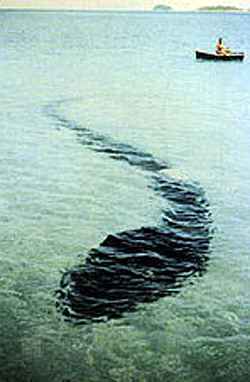
Next Naish discusses the famed pictures (below) taken at Moore’s Beach (now Natural Bridges State Beach), northwest of Santa Cruz, California, in 1925. They are routinely published as shocking photos of a beached sea serpent, but Naish talks of their real origin.
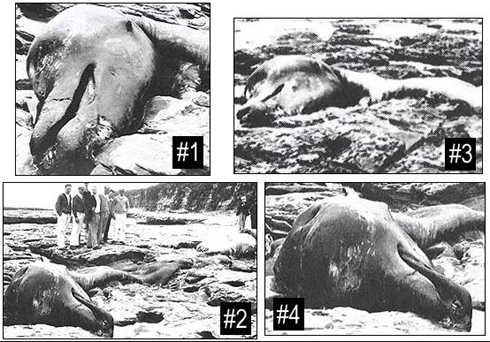
For you see, this so-called “Santa Cruz Monster” was identified almost immediately. The carcass was a decomposed Baird’s beaked whale, or Baird’s fourtooth whale, Berardius bairdii. It is not stored in some hidden basement, but at the California Academy of Sciences. Thomas J. Gehling took images (one below) of the skull and shared them with Naish.
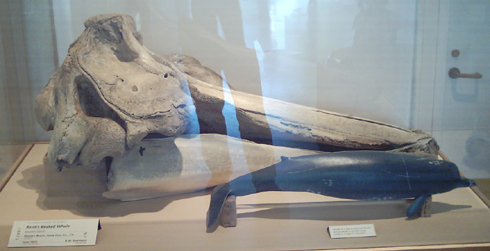
On the third day, Naish turned his attention to a 1908 article from the San Francisco Examiner entitled “To Catch a Sea Serpent.” The article’s photo (below) extends across two pages and depicts an elongated, two-humped creature in the water. The caption explains that the photo – described as “the first photograph of a sea serpent” – was “taken by Prof. Sharpe from the steam yacht Emerald as the monster rushed past at 20 miles an hour.”
Darren Naish writes of this one: “While, probably, the photo is faked, it’s not possible to demonstrate this at the moment.”
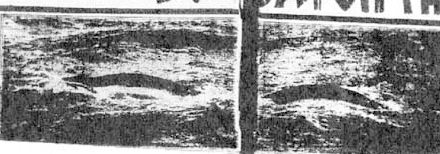
On Thursday, Naish debunks rightfully, the Tecolutla Monster (below), collected from Palmar de Susana between Tecolutla and Nautla, Veracruz, Mexico, in 1969. The creature wasn’t really a mystery for long. Also, here again too, the skull has been retained and there is little doubt this is only a whale.
As Naish observes: “Even in 1969, however, some people had gotten it right. Ivan Sanderson had said in Pursuit magazine that it was a whale….”

Finally on the fifth day, Naish entitled his last “sea monster week” posting: “Where are all the dead sea monsters?”
Naish takes on a hodgepodge of photos, including one from Cryptomundo.

Here is what the Tetrapod Zoology blog says about the two most of you are familiar with from these pages:
“The two images shown [above here] feature (at top) a weird fat-headed creature depicted on a pre-1914 postcard (discussed extensively at Cryptomundo by Loren Coleman…. I am confident that it is not a real animal), and the famous Naden Harbour Cadborosaurus carcass. These sorts of photos represent the best sort of evidence we have for ‘those that still seem to defy explanation’. In other words, I can’t say that we can come away from the carcass evidence (such as it is) feeling at all good about the reality of these creatures.”
I tend to share Naish’s frustration with still seeing all of these well-known explained “Sea Monster” photographs used over and over again, often rather sensationally. But for the Naden Harbor carcass, certainly, we do have reasons for continuing some careful questioning with regard to that one.
As far as the “Mystery Fish” on the postcard, I won’t go so quickly to the place that Naish occupies (more or less he says the “fish” is a fake). I’ll wait to see the paper-mâché artifact first before I would so rapidly declare this is a prank or hoax! 🙂
Finally, the April 25, 1977, the Japanese trawler Zuiyo-maru images are there too. This decomposed body was known to be a basking shark, as soon as the specimen samples were analyzed, and the results published in 1978. But that has hardly stopped various Zuiyo-maru pictures from turning up over and over again as “sea monster” proof.
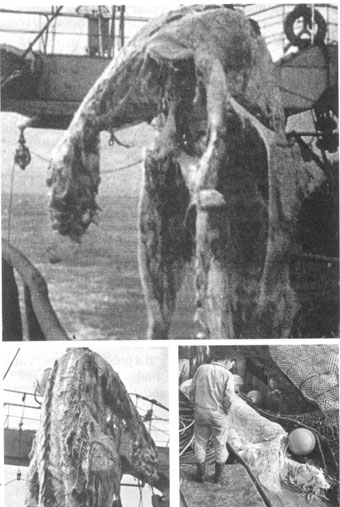
Other intriguing side treks are taken by Naish too:
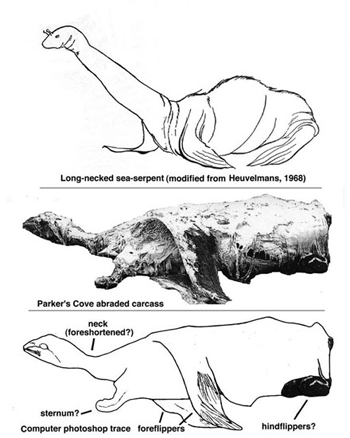
I encourage everyone to visit Darren Naish’s postings (the links are embedded above) so you can read the entire nature of his blog’s insights, if interested. Needless to say, however, you must be aware what the verdict will be for most of the photos before you reach the end of each posting.
If any one of them happened to be an actual photograph of a credible, verified “Sea Monster,” of course, it won’t be part of this discussion, now would it? It would be in a zoological textbook.
About Loren Coleman
Loren Coleman is one of the world’s leading cryptozoologists, some say “the” leading living cryptozoologist. Certainly, he is acknowledged as the current living American researcher and writer who has most popularized cryptozoology in the late 20th and early 21st centuries.
Starting his fieldwork and investigations in 1960, after traveling and trekking extensively in pursuit of cryptozoological mysteries, Coleman began writing to share his experiences in 1969. An honorary member of Ivan T. Sanderson’s Society for the Investigation of the Unexplained in the 1970s, Coleman has been bestowed with similar honorary memberships of the North Idaho College Cryptozoology Club in 1983, and in subsequent years, that of the British Columbia Scientific Cryptozoology Club, CryptoSafari International, and other international organizations. He was also a Life Member and Benefactor of the International Society of Cryptozoology (now-defunct).
Loren Coleman’s daily blog, as a member of the Cryptomundo Team, served as an ongoing avenue of communication for the ever-growing body of cryptozoo news from 2005 through 2013. He returned as an infrequent contributor beginning Halloween week of 2015.
Coleman is the founder in 2003, and current director of the International Cryptozoology Museum in Portland, Maine.










Glad to have a clarification on the Mexican creature. That one has always been interesting.
It was an interesting, effective, and not entirely
depressing survey of a number of photographs. While
I chided him slighty for it at the outset, I do respect
the need fro this sort of critical thinking in all areas
of Fortean invetigation.
I really enjoyed reading thru this and the other linked articles. It would be great to find out the colorful history behind many of the other iconic “fortean” photos.